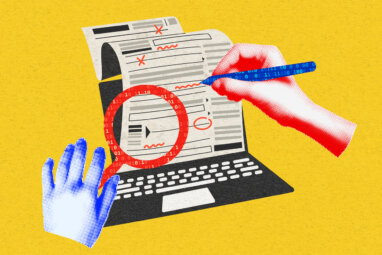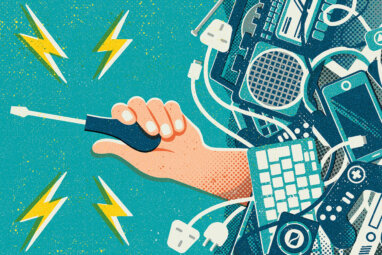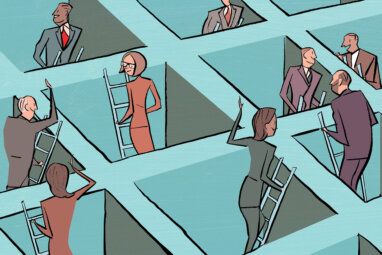The Digital Twin Opportunity
Developments in enabling technology are opening up more use cases for virtual models of real-world objects.
Topics
Frontiers

Image courtesy of Carlo Giamberresi/theispot.com
Half a century ago, NASA’s moon shot landed Neil Armstrong and Buzz Aldrin on the moon and set fire to our imaginations. Technology innovations from the program went on to seed entire industries, including microelectronics, software, and communications, which now form the backbone of our digital century. Another innovation was that NASA built and maintained a physical twin of the spacecraft on the ground so that it could troubleshoot problems without risk to the mission. This proved crucial during the troubled Apollo 13 mission and helped NASA bring the astronauts home safely. This basic concept has now evolved into the use of digital twins, or DTs — still twins, but built and maintained in the digital rather than physical realm. Fundamentally, a DT is a dynamic model of a physical system that enables fast and creative experimentation at very low cost and risk.
DTs have already been used in specialized, complex applications like observing and modeling the operation of an aircraft engine or manufacturing equipment. These initial DT deployments were tactical, mainly for data visualization and product life cycle management. But now, thanks to a confluence of technological advances, DTs are at an intriguing inflection point — transitioning from that specialized, tactical domain to becoming strategic tools with diverse applications.
Leaders now have an inspiring opportunity to harness DTs for today’s moon shot: achieving business success while helping our planet and humanity. They can use DTs to strategize new cross-disciplinary opportunities and drive smart digital transformation. And they can use DTs to achieve aggressive sustainability goals and enhance the health and safety of their employees and communities.
How Digital Twins Are Advancing
What makes a DT special is that it is dynamic — it must always mirror the exact state of the physical system. This requires two key parts to work in tandem: a model describing the behavior of its physical twin, and sensors that provide the real-time “coupling” to the model. For example, a DT created to capture the occupant experience inside a building must reflect the temperature, humidity, air quality, and several other attributes of every room. Buildings, like all physical systems, are notoriously difficult to model because they change over time: Pipes rust, heating coils degrade, and beams weaken. Biological systems such as forests, fields, and humans change even more unpredictably. For aircraft or manufacturing operations, such changes are easier to monitor with ubiquitous sensors, and the cost is justifiable due to the large capital investments already at stake. For most other systems, modeling and measurement have been difficult and unaffordable until recently.
What has changed is that multiple technologies have come of age and can now be combined in unique ways. The internet of things (IoT) has matured, so we have ever-cheaper sensors to measure many new physical parameters accurately. 5G communications networks allow wide-bandwidth data transmission at almost real-time speeds. Advances in augmented reality (AR) and virtual reality (VR) allow us to see a realistic 3D visualization, whether of a bridge, a building, or a human organ. Artificial intelligence (AI) and machine learning techniques help us model how a system functions and sometimes even predict how it might work in future scenarios. Coupling to real-time IoT data anchors these models in reality and transforms the DT into a powerful tool. Now we can do far more than just observe — we can diagnose, control, and sometimes even provide a prognosis for diverse physical systems. So how do we use this new capability?
Where DTs Can Help Target Strategic Priorities
At the Center for Information Technology Research in the Interest of Society (CITRIS) and the Banatao Institute, one of the University of California’s research and innovation centers, we are working with partners in industry, government, and academia to develop accurate DTs for diverse applications such as buildings, mines, vehicles, renewable energy assets, dams, forests, and even human tissues and organs.
Based on our experience with Siemens, Komatsu, Kajima, Enel Foundation, Lam Research, SEMI, and the National Research Foundation of Singapore, we see three high-level priorities common among business leaders where there is strong potential for harnessing DTs: sustainability, smart innovation, and health and safety.
Sustainability. Sustainability is an increasingly high-priority strategy for many global corporations and organizations, and many have set aggressive goals to achieve carbon neutrality in the next 10 to 20 years. DTs can be invaluable in achieving these sustainability goals by helping to reduce energy consumption drastically and supporting more efficient development of green alternatives.
Buildings account for almost 40% of the world’s energy consumption and a proportionate level of greenhouse gas emissions. In our work, we find that DTs can help lower the energy consumption in commercial buildings by almost half.
It is difficult to experiment on an actual building without disrupting operations, incurring much expense, and adding risk to the occupants. So as a pilot project through our partner program with the Berkeley Educational Alliance for Research in Singapore, we created and applied a DT to a primary school in Singapore, with the goal of minimizing energy consumption while ensuring a healthy and comfortable environment for the children. To create this DT, we developed a portable, easy-to-install sensor suite to measure the actual “state” of the building and coupled this with models based on AI and machine learning to visualize occupancy, air quality, lighting, and ventilation. We could then experiment safely and swiftly with the DT to find an optimal solution. This basic approach can be expanded to any building, and we are now working with Siemens on an advanced implementation.
We also find that DTs can benefit industries like construction, quarrying, and mining, whose basic operations generate greenhouse gases. We have shown that DTs can improve equipment efficiency and reduce emissions significantly. These innovations also help larger global sustainability goals, because ironically, even “green” alternatives require more mining — electric vehicle batteries need lithium, high-efficiency electric motors need rare earth elements, solar panels need aluminum, and so forth.
Smart innovation. Much current innovation focuses on adding “intelligence” to things: Cars, homes, energy, agriculture, infrastructure, and cities, for instance, are all being made “smart.” DTs can support the innovation necessary for this digital transformation to smart systems.
For example, we have created DTs to make wind turbines smart by combining fiber-optic sensing techniques with AI and machine learning models. By measuring and modeling every detail of the turbine, we created a DT that reflects the turbine’s state at all times. It even predicts when a specific bolt, out of thousands that secure the turbine, is coming loose. This reduces maintenance costs, prevents catastrophic failure, and enhances the reliability of renewable energy. Using similar innovations in sensing and modeling, we are adding smarts to dams so that they can warn of an imminent breach, and to roads so that they can help traffic flow more smoothly. Our DTs for smart agriculture use aerial drones and ground-based agricultural robots to determine the exact requirements of each plant or tree. This ensures the precise delivery of water, fertilizer, and pesticides, with minimal waste. These DT-driven innovations enhance food security and also mitigate the water crisis in drought-prone regions like California.
Health and safety. The pandemic shone a spotlight on remote health care as telehealth visits increased dramatically. This trend will likely endure for reasons of safety and convenience — and in remote locations, where local medical expertise may be limited. However, the quality of a telehealth visit must improve beyond basic audio or video. In two large pilot programs for underserved rural communities, we are exploring real-time sensors to monitor patients, AI to analyze patient data, and AR/VR for better visualization. These DT elements provide physicians with timely data and fast analytical tools so that they can diagnose and treat illnesses quickly.
DTs can also improve workplace safety. We have shown that they can accurately model and predict the spread of viral pathogens through droplets inside chip production environments. These clean rooms are vital to the $3 trillion electronics ecosystem, and any shutdowns can result in the loss of billions of dollars. The DTs guide facility managers to develop safer practices for workers to operate productively while minimizing the risk of infection.
Best Practices for Implementing DTs
DTs have exciting potential but are challenging to implement because they integrate multiple technology platforms and require significant funding, talent, and expertise. If these technology and organizational elements are not planned and executed effectively, DT projects can end in frustration and disappointment. To help leaders and teams succeed, we offer four succinct recommendations for increasing the probability of success in DT projects.
1. Inspire with a clear goal and solid business case. We find it critical to start with a well-articulated goal that inspires people and translates into an actionable business case for a DT project. For example, in our smart-buildings project, we motivated a global cross-disciplinary team of 200 researchers with a simple but compelling goal: to reduce building energy consumption by half without compromising its performance. Translating this into a business case was straightforward, because these energy savings correlate directly with cost savings and a reduction in emissions.
2. Blend physics and AI optimally when designing a DT model. Both AI-based models and physical models have limitations. AI models depend on large amounts of data, and it’s not always possible to collect or generate enough for the level of accuracy required. Further, such models lack physical insight. An autonomous car does not “understand” that it is in hilly San Francisco and not flat Dallas — and an AI model may not know what it does not know, which could lead to a catastrophic accident. Meanwhile, pure physics-based models offer great intuitive insight but are limited by what we can measure.
We have determined that a hybrid approach blending physics and AI works best, because it leverages the best of both worlds and overcomes the limitations of each. In our quarrying DT, we use AI to model the autonomous operation of an earthmover but blend it with a physical model of the soil and rocks it is digging. Similarly, for our health DT, we use the technology to model a dexterous robotic hand but blend it with physical models of the skin and tissue it is operating upon.
3. Build cross-disciplinary expertise. Cross-disciplinary opportunities require synergy between technology platforms and application domains. Experts in health, agriculture, mining, and construction must work with AI, IoT, software, and hardware professionals. This is easier said than done, given that any single organization may not have all of this expertise. Leaders must be proactive in forging thoughtful partnerships to ensure that their teams have the right talent mix of technology and domain knowledge.
4. Drive a data strategy from the top down. DTs live or die by the relevance and accuracy of the data being measured and modeled. Data acquisition is often at least as much a business challenge as it is a technical one and cannot be an afterthought. Leaders must ensure that there is a top-down strategy to provide access to the right data, and to guarantee its quality, provenance, and security.
From their earlier applications in the tactical monitoring of specialized machinery, DTs are now becoming strategic tools for diverse applications because they can increasingly diagnose, control, and even predict the behavior of complex physical systems. The time is ripe for business leaders to consider how they can harness DTs to pursue new growth opportunities. DTs are particularly useful in exploring strategic cross-disciplinary opportunities, where it is risky to experiment on the real thing, whether it is a building, an earthmover, or a person. Especially exciting is the potential to use DTs to create business value while also meeting sustainability targets and improving people’s lives.
What if we could stop the next pandemic in its tracks? What if we could cut global energy consumption and greenhouse gas emissions by a third? What if pediatricians could better treat ill or injured children in remote rural clinics? DTs may be able to help us address such grand challenges successfully.








